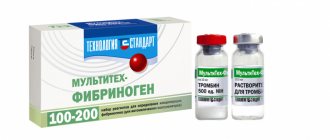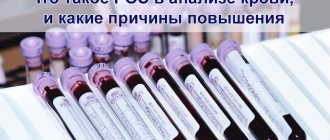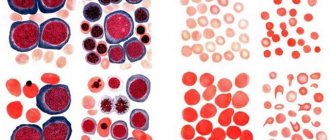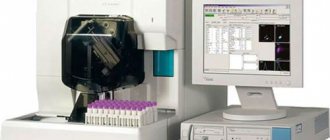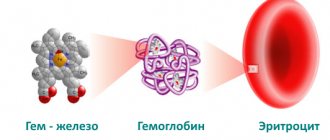Thrombocrit - what is it?
Thrombocrit is a blood test indicator that indicates what proportion of whole blood consists of platelets.
The value of this general analysis parameter is determined only by a hematology analyzer and is calculated using the formula: platelet count * average platelet volume (MPV) * 10-4.
The value of the PCT indicator is directly affected by the average platelet volume MPV, as well as factors such as smoking, lack of vitamins B12, B9, B6, and depressive disorders.
Knowledge of the study results allows us to assess the effectiveness of the blood coagulation system. The test indicator reflects the human body’s tendency to bleed or form blood clots.
A thrombocrit test is prescribed as part of a comprehensive examination:
- heart and blood vessels;
- kidney;
- reproductive organs;
- endocrine system;
- respiratory organs;
- immune system.
Based on the test results, the risk of possible complications during organ transplantation is assessed and the course of diseases during treatment with immunosuppressive drugs is predicted.
Knowing the PCT value allows one to assess the risk of thrombosis when prescribing medications that affect the parameters of the coagulation system. Such an assessment is necessary for drawing up a treatment regimen and predicting the outcome of the disease in bedridden patients, with artificial ventilation, and before surgery.
Significance in diagnosis
First of all, by determining thrombocrit indicators, the following aspects are established:
- Determination of the risk of bleeding, increased thrombosis (thrombocytosis condition).
- Assessment of the benefit/risk ratio when prescribing certain medications.
The most well-known reasons for determining this indicator in the blood are:
- The patient has a high temperature of unknown origin.
- Evaluation of treatment with immunosuppressive drugs.
- Severe viral, bacterial, fungal infection of the body.
- The patient is on artificial ventilation.
- Complications after organ transplantation.
Important. It is necessary to take into account that any change in the number of platelet germ cells - an increase (thrombocytosis), a decrease (thrombocytopenia), a change in shape, aggregation - immediately affects the thrombocrit numbers.
- Thrombocrit is increased in the blood of an adult and a child. What does this mean, treatment
To assess platelet distribution in peripheral blood, it is necessary to know its normal values.
Functions of platelet cells
A specific feature of blood platelet cells is their ability to stick together and attach to the vascular intima due to special outgrowths (pseudopodia).
As a result, primary platelet clots are formed, which play an important role in the process of stopping bleeding.
Normally, the number of platelet cells in the blood can change significantly due to stressful situations, physical activity, exposure to a painful stimulus, viral and bacterial diseases (high platelets in a child under one year old are often associated with a past infection), etc.
It should be noted that in the implementation of the main function of platelets (participation in hemostasis processes), the presence of platelet cells on the granules and membrane surface plays an important role:
- specific platelet factors (partial thromboplastin, antiheparin factor, thrombostenin);
- vasoconstrictor factors (serotonin, adrenaline, norepinephrine);
- thromboxane;
- circulating immune complexes, etc.
The participation of platelets in the formation of immune responses is due to their phagocytic activity, the content of IgG, lysozymes and beta-lysines (lysozyme and beta-lysine are capable of destroying the membranes of some bacterial cells).
- Platelets - their role in the body and what threatens a deviation from the norm (increase or decrease in platelets)
Platelets also contain specific peptide factors that can stimulate the transformation of “null” lymphocyte cells into mature T- and B-lymphocyte cells.
Due to this, in case of vascular injuries, platelet cells not only help stop bleeding, but also prevent pathogenic microorganisms from entering the body.
Watch this educational film about platelets with your child:
When thrombocrit is low
A decrease in PCT occurs when the production of platelets or platelet precursors, which are megakaryocytes, is blocked. With a decreased PCT, there is a tendency to bleed.
This indicator is reduced during pregnancy. The drop in thrombocrit in women can be 2 times lower than normal, but during pregnancy this reduces the risk of thrombosis, and means that blood circulation and fetal nutrition will not be affected.
PCT decreases in conditions caused by:
- anemia - folate deficiency, aplastic, megaloblastic;
- autoimmune diseases – systemic lupus erythematosus, collagenosis;
- chronic diseases of the liver, kidneys;
- poisoning by poisons, drugs - diuretics, cytostatics, antibiotics, corticosteroids;
- chemotherapy;
- oncological diseases - hemoblastosis, leukemia.
When the thrombocrit is lowered and is less than 0.11%, then in adults this indicates a disorder of hematopoiesis in the bone marrow or an acceleration of the breakdown of platelets in the spleen.
A low PCT thrombocrit in a child’s blood test may be explained by:
- in infants - prematurity, low birth weight, hypoxia;
- in a child of an older age group – parasitic infection.
Normal indicators
The PCT indicator, which is nothing more than thrombocrit, cannot be determined without special modern equipment, since platelets, being outside the bloodstream, are able to “overgrow” with pseudo-similarities.
At the same time, they still manage to increase in size at least ten times. It is for this reason that a laboratory technician cannot do without an automatic analyzer when determining the thrombocrit index. Determination of thrombocrit level in blood
The norm for this indicator ranges from 0.15 to 0.4. In some medical publications you can find information in which the thrombocrit norm differs slightly from that indicated, but only slightly. The norm for this indicator in an adult, an infant or in children of different ages is proportionally different from each other. At the same time, a proportional change in the indicator is not observed due to physiological fluctuations.
In particular:
- during the day or at different times of the year, the thrombocrit indicator may deviate by 10% (in particular, when depression occurs at night or in early spring);
- in women, thrombocrit is reduced by 50% during menstruation, as well as during pregnancy (this is a kind of protective reaction of the body that prevents the formation of blood clots);
- Thrombocrit indicators will be doubled if the patient was subjected to significant physical activity before the analysis.
Lack of platelets
But what to do if, on the contrary, the thrombocrit is low? There are a lot of cases when there is not enough thrombocrit in the blood and its amount drops below normal. A case where the thrombocrit is below normal is otherwise called thrombocytopenia. The most common cause of thrombocytopenia is taking medications that are inappropriate for the body. That is, in this case, thrombocytopenia manifests itself as a side effect of the drug. A decrease in platelet count appears from cirrhosis, hypothyroidism, leukemia, hepatitis, bone marrow dysfunction, alcohol abuse and anemia.
In addition, thrombocytopenia may occur if the patient has recently had a tooth pulled out. The appearance of thrombocytopenia leads to a loss of elasticity of blood vessels, as a result of which they become more fragile.
To determine the causes of a decrease in platelets, the doctor prescribes the following tests:
- Ultrasound of the liver and spleen. This is necessary in order to identify tumors, if any. In addition, ultrasound helps to study in detail the density and size of internal organs.
- Genetic research. It is carried out to determine hereditary thrombocytopenia, again if there is one.
- Magnetic resonance imaging.
- Blood test for various antibodies.
The reasons described above are the most common, and only after all these studies can the doctor prescribe pharmacological drugs to the patient that will help get rid of thrombocytopenia.
- What does a deviation from the norm indicate?
RDW and PDW in general blood test22779
Platelets in babies
The norm of platelets in children (their content in the blood) is directly dependent on age:
- in newborns up to the 10th day from birth – 100-420×109/l of blood;
- in babies under 1 year of age – 150-350×109/l;
- in children after 1 year, as in adults – 180-320×109/l.
If the platelet count doubles, doctors consider it a critical condition.
Elevated platelet levels in children may indicate the presence of serious diseases such as leukemia.
Elevated platelet levels: what to do?
What to do if there is an excess of thrombocrit, and it is above normal, and what could this mean? It must be remembered that if the thrombocrit is elevated, then this is dangerous in any case, and you should not delay treatment. Absolutely always, the presence of an excess of blood platelets indicates one of the diseases that are described below:
- Arthritis.
- Enteritis.
- Leukemia.
- Erythrocytosis.
- Lymphogranulomatosis.
- Chronic myeloid leukemia.
- Anemia.
- Hemolysis.
- Kidney/liver cancer.
In addition, increased thrombocrit can appear from an acute infection in the body, large blood loss, severe stress and poisoning. A case where the thrombocrit is higher than normal is also called thrombocytosis.
There is also so-called “secondary” thrombocytosis. It appears with too much weight, alcohol abuse and various injuries. In this case, the culprit is thrombopoietin, which is responsible for cell maintenance, division and maturation, which is found in the bone marrow. In the presence of secondary thrombocytosis, the amount of thrombopoietin in the blood increases.
In any case, doctors recommend paying special attention to these cells, and if they are damaged, consult a doctor. If the patient is confirmed to have a high platelet level, he is prescribed an ultrasound of the abdominal cavity of the pelvic organs, blood and urine tests, and a test to detect C-reactive protein. And only after all these studies, the attending physician will be able to find out the real causes of thrombocytosis.
General blood test - transcript online
Using the online test interpretation service, you can check your results in a general blood test.
We take into account both the patient's gender and age, since the results can vary greatly in these cases. All parameter maps were compiled using medical literature. To start working with the service, indicate the gender and age of the person and select the parameters that interest you. Do not self-medicate. At the first signs of illness, consult a doctor.
The reasons why platelets in a child’s blood are higher than normal can only be determined through diagnostic measures. The clinical picture for a violation of this nature will be rather nonspecific, therefore it is strongly not recommended to independently compare the clinic and therapeutic measures. This is extremely dangerous for a child and can lead not only to complications, but also to death.
Diagnostically, an increase in platelets in a child’s blood is determined by laboratory tests. Instrumental diagnostics are carried out if necessary, depending on the current symptoms.
The prognosis is entirely individual, since everything will depend on the provoking factor and the age of the child, the state of his immune system.


